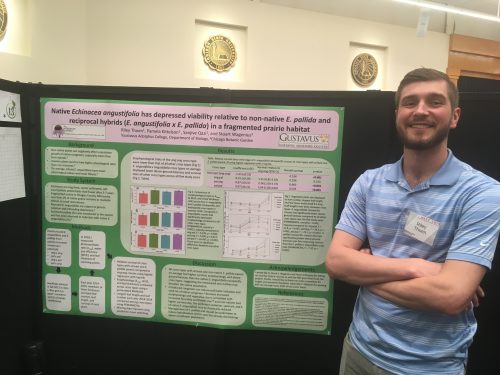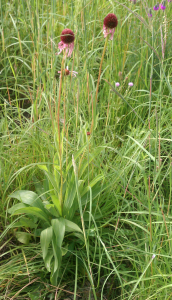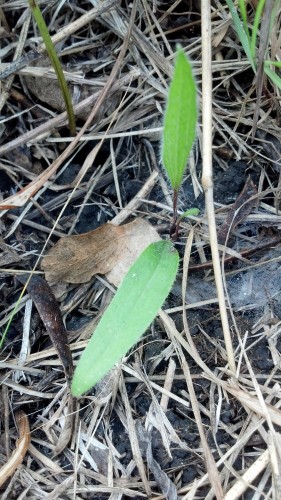|
|
Last Friday, I was dispatched by Stuart to find the number of plants/ achenes planted in each experimental plot, along with the number alive as of a recent year (2017-2019, based on the plot). Although records of some plots were a bit harder to come across that others, I was able to compile data from each plot (besides p10 – planted 2019 – data coming soon). This would not have been possible without the help of Gretel, so thanks GK! I have attached a small datasheet with the survival data.
In the history of the Echinacea Project, the team has sown 31,888 Echinacea viable achenes in experimental plots. There were many more sown that likely did not have a seed. Team members found 3634 seedlings from these seeds, not including Amy D’s experimental plot 3 and remnant seedling refinds. The team has planted 18,869 Echinacea seedlings in experimental plots, not including p10 – planted at West Central Area HS in 2019. Finally, 7090 Echinacea are currently alive in the experimental plots!
Next up from MEEC we have Riley’s poster about the photosynthetic rates of Hybrid plants in exPt7. Riley collected the data for this project in the summer of 2018, and has been working on aggregating and analyzing since then. The central question behind the research: do Echinacea hybrids between E. angustifolia and E pallida have higher photosynthetic rates than conspecifics?
 Riley with his poster Overall (as the title says), Riley found that E. angustifolia may be in trouble if it has to compete with E. pallida. Both the hybrids and conspecific E. pallida plants were more photosynthetically active than E. angustifolia. Additionally, they had higher survival rates. And to put the final nail in the coffin, the only plant that has flowered in exPt7 is an E. pallida plant. All things considered, Riley’s work is crucial to finding out how to protect E. angustifolia from this invasive species!
Click the link bel0w for a full .pdf of Riley’s Poster
echinaceaPoster2_Thoen
Title: Native Echinacea angustifolia has depressed viability relative to non-native E. pallida and reciprocal hybrids (E. angustifolia x E. pallida) in a fragmented prairie habitat
Presented at: MEEC 2019 at Indiana State University in Terre Haute, IN
When: April 27th, 2019
In summer 2018, we searched experimental plot 7 for Echinacea plants that are crosses between and within E. angustifolia and E. pallida. Of the 294 plants originally planted, we found 169. However, for the first time in the history of experimental plot 7, we found a flowering plant (an E. pallida x pallida cross)! The table below shows the counts of Echinacea plant in the summer of 2018. In addition to the lowest survivorship, the native E. angustifolia also has been the smallest (above-ground) over the five experimental years. Uh oh!
 Riley with the first ever flowering head in exPt7!
| Status 2018 |
ang x ang |
ang x pal |
pal x ang |
pal x pal |
| not found |
52 |
12 |
26 |
35 |
| found |
22 |
16 |
59 |
72 |
Start year: Crossing in 2012, Planting in 2013
Location: Hegg Lake Wildlife Management Area – Experimental Plot 7
Overlaps with: Echinacea hybrids: exPt6; Echinacea hybrids: exPt9
Data collected: Rosette number, leaf number, length of longest leaf, herbivory for each plant collected electronically and exported to CGData. Recheck information for plants not found was also collected electronically and stored in CGData. In 2018, Riley also used a Li-Cor 6400 to analyze ecophysiological traits of Echinacea in expt7. This included photosynthetic rate and water use efficiency. Riley has this data and we’ll make it available after he’s done with his thesis.
Products: Riley’s 2018-19 Biology Honors Project at Gustavus. Riley found that within-species Echinacea angustifolia crosses have lower survivorship, above-ground biomass, and ecophysiological traits than other cross types. Riley made a poster, is writing his thesis, and will defend it in May.
You can read more about rexPt7, as well as links to prior flog entries mentioning the experiment, on the background page for this experiment.
Hello Echinacea folks! After a great summer at the Echinacea Project, I returned to Gustavus to work on the morphological and physiological data I collected at experimental plot 7. In my time at Gustavus so far, I wrote a proposal for my project so I can analyze my data and undertake a senior honors project under familiar Echinacea advisors Pamela Kittelson, Stuart Wagenius, and Sanjive Qazi. I have also worked on a methods section for my final honors paper and made a poster (attached below). In addition to my project, this fall I have been working on a project to implement composting and sustainable practices in Saint Peter restaurants and a project analyzing microRNA-mediated stress response in smooth cordgrass. The next steps for my honors project are to write up an introduction and do statistical analysis over our January-term. I will be performing aster and cluster analyses and am really excited to get back into some R coding! echinaceaPoster1_Thoen
This summer, we measured hybrid Echinacea plants in experimental plot 7 at Hegg Lake. 159 of the original 294 planted seedlings (54%) were found this year. We searched 243 of the 294 positions where plants were originally planted (the other 51 positions were not searched because plants have not been found for at least three years in a row). The table below shows the fate of plants in 2017 summarized by cross-type — the first name in the cross type is the maternal species, and the second name is the paternal species (e.g., ‘ang x pal’ is angustifolia mother and pallida father).
| Status 2017 |
ang x ang |
ang x pal |
pal x ang |
pal x pal |
| not found |
53 |
10 |
33 |
35 |
| found |
21 |
18 |
52 |
72 |
 Flowering Echinacea angustifolia. Start year: Crossing in 2012, Planting in 2013
Location: Hegg Lake Wildlife Management Area – Experimental Plot 7
Overlaps with: Echinacea hybrids: ex Pt 6; Echinacea hybrids: ex Pt 9
Data collected: Rosette number, length of all leaves, herbivory for each plant collected electronically and exported to CGData. Recheck information for plants not found was also collected electronically and stored in CGData.
Products: Taylor Harris’s 2015 poster demonstrating fitness benefits of pallida parenthood.
You can find more information and links to previous flog entries involving experimental plot 7 on the background page for the experiment.
 Echinacea pallida observed at Hegg Lake. This summer, we remeasured plants in experimental plot 7 at Hegg Lake. These plants are hybrids of Echinacea angustifolia (native) and Echinacea pallida (non-native, but planted at a nearby restoration). Shona Sanford-Long performed these crosses in 2012, Jill Pastick germinated the seeds that winter, and Stuart planted the seedlings the following spring. It is not yet known how the introduction of this non-native species will affect local Echinacea angustifolia populations. The survival rates and reproductive fitness of these plants can tell us how well the hybrids can compete with the native species. We have returned to the plot each of the last three years and measured the plants found there.
198 of the original 294 planted seedlings (67.3%) were found this year. The table below shows the fate of each cross-type in 2016 — the first name in the cross type is the maternal species, and the second name is the paternal species (e.g., ‘ang_pal’ is angustifolia mother and pallida father). These plants were measured on August 3rd and rechecked on September 2nd. No plants flowered this year, meaning that we must wait longer to assess seed set and reproductive fitness.
Cross Type
Found16 ang_ang ang_pal pal_ang pal_pal
no 34 10 20 32
yes 37 21 65 75
Start year: Crossing in 2012, Planting in 2013
Location: Hegg Lake Wildlife Management Area – Experimental Plot 7
Overlaps with: Echinacea hybrids: ex Pt 6; Echinacea hybrids: ex Pt 9
Data collected: Rosette number, length of all leaves, herbivory for each plant collected electronically and exported to CGData. Recheck information for plants not found was also collected electronically and stored in CGData.
Products: Taylor Harris’s 2015 poster demonstrating fitness benefits of pallida parenthood.
You can find more information and links to previous flog entries involving experimental plot 7 on the background page for the experiment.
 A hybrid at Hegg Lake In 2015, we continued an experiment that quantifies fitness of Echinacea angustifolia x pallida hybrids and pure-strain plants. Out of the the original 522 plants, 323 were still alive in 2015, which is a survival rate of 62%. The mean leaf length of these plants was roughly 11.7 cm. Stuart planted the 522 seedlings at Hegg Lake WMA in spring 2013. The seedlings result from hand reciprocal crosses conducted by Shona Sanford-Long during the summer of 2012.
Read more posts about this experiment here.
Start year: 2013
Location: Hegg Lake Wildlife Management Area – Experimental plot 7
Taylor presented a poster of her summer research on fitness of native, non-native, and hybrid Echinacea plants at the Tennessee Louis Stokes Alliance for Minority Participation Conference. The meeting was held February 25-26, 2016 at the University of Tennessee-Knoxville. Taylor was awarded 3rd place in Science Poster Presentation category. Yay, Taylor!
Invasive Potential of E. pallida in Western Minnesota:
TAYLORS
Here is the latest draft of my proposal to investigate the survival rates of Aphis echinaceae on Echinacea hybrids and the impact they have on host fitness:
CMS_proposal_8Jul2014.pdf
I’m excited to get started. In addition to my main project, I will be conducting and coordinating a variety of side projects related to aphids and Echinacea hybrids:
1. Katherine Muller and Lydia English’s aphid addition/exclusion experiment in P1.
2. Assessing fitness of the two Echinacea species and their hybrids in P6 (Josh’s Garden) and P7 (at Hegg Lake).
3. Recording flowering phenology of Echinacea pallida at Hegg Lake, where they were planted in a prairie restoration.
|
|





